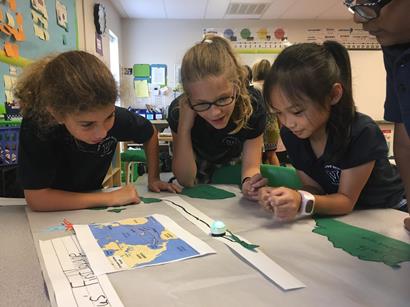Coding and computer programming are slowly becoming part of the core curriculum in schools and districts across the U.S.–and some educators say the earlier students start coding, the better.
Research says students are more likely to maintain their interest in coding if they’re exposed to it at an early age, and now, some schools are starting in elementary school.
At The Village School in Houston, TX, instructional technology specialist Ruth O’Brien and middle school teacher Marc Abrate are helping students develop skills that help not only in coding, but in areas such as problem solving, critical thinking, and collaboration.
Coding has been a required part of the middle school and elementary school curriculum since 2014.
Teachers attend coding workshops and receive training at school. Students in fourth grade are trained to use devices to code, and they also have to train their peers and students in other grades.
“The younger kids love to learn from the older kids. Providing the proper devices and training for young children gets them excited and inspired,” O’Brien and Abrate say.
The school uses resources and apps such as Unplugged.org, Kodable, Tynker, codeSpark, and Scratch Jr. Students use devices such as Ozobots, SAMLabs, Makey Makey, Code-a-Pillar, and Dash & Dot.
In middle school, students use Scratch Studio and Code.org’s Code Studio for creative applications such as making games, drawing animations, and controlling drones, O’Brien and Abrate say.
“We have several LEGO robotics classes, and we also introduce students to programming for the web, teaching them HTML, CSS, and Javascript in seventh and eighth grade,” adds Abrate.
One third grade coding project tasked students with researching an extinct animal species, building a model of the animal’s habitat, and developing a code to simulate a mini journey of the animal using Ozobots.
It was an inspiration, prompting teachers in other grades to incorporate coding into project-based learning and special presentations.
“Once they see how students interact and the multiple benefits that come from coding it quickly becomes a part of their classroom curricula,” O’Brien says.
Many students, particularly girls and underrepresented minorities, can lose interest in STEM in late elementary school or early middle school, which is when STEM becomes more challenging. It’s also when peer pressure can make STEM engagement and enthusiasm seem uncool. But exposing students to coding in the early grades has helped The Village School avoid some of this STEM drop-off, O’Brien and Abrate say.
“Because of our standards and curriculum, we haven’t experienced elementary students feeling peer pressure, or any girls underrepresented,” they say. “The younger students are still learning code and they’re very excited to learn. Part of the reason we made it mandatory is because students, especially young girls, who think they can’t do it, won’t understand it, or are intimidated by it, won’t try it.”
The school has a group of students designated as tech leaders, and students in this group are trained on how to use coding devices and teach other students.
“We’re proud to say the group has an equal amount of both boys and girls,” O’Brien says.
Abrate and O’Brien urge other schools hoping to set up a core coding curriculum to offer training at school, and possibly off campus as well, for staff. Once educators know the basics, they can step back and let students take more ownership as they explore coding.
Including everyone is key, they say.
“It’s important to include everyone on campus to be involved with code. Our librarian offers books about coding and teaches code lessons,” O’Brien says. “Our foreign language teachers and ELL teachers also integrate coding in their classes. It becomes second nature and the norm for everyone on campus. We collaborate a lot.”
- Friday 5: Virtual field trips - April 26, 2024
- Google, MIT RAISE launch no-cost AI training course for teachers - April 26, 2024
- 4 ways to support work-based learning - April 23, 2024

